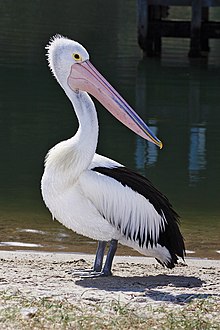Australian pelican
| Australian pelican | |
|---|---|
 |
|
| Scientific classification | |
| Kingdom: | Animalia |
| Phylum: | Chordata |
| Class: | Aves |
| Order: | Pelecaniformes |
| Family: | Pelecanidae |
| Genus: | Pelecanus |
| Species: | P. conspicillatus |
| Binomial name | |
|
Pelecanus conspicillatus Temminck, 1824 |
|
The Australian pelican (Pelecanus conspicillatus) is a large waterbird of the family Pelecanidae, widespread on the inland and coastal waters of Australia and New Guinea, also in Fiji, parts of Indonesia and as a vagrant in New Zealand. It is a predominantly white bird with black wings and a pink bill. It has been recorded as having the longest bill of any living bird. It mainly eats fish, but will also consume birds and scavenges for scraps.
The Australian pelican was first described by Dutch naturalist Coenraad Jacob Temminck in 1824. Its specific epithet is derived from the Latin verb conspicere, meaning 'to behold', and refers to the 'spectacled' appearance created by its conspicuous eye markings.
The Australian pelican is medium-sized by pelican standards, with a wingspan of 2.3 to 2.6 m (7.5 to 8.5 ft). Weight can range from 4 to 13 kg (8.8 to 28.7 lb), although most of these pelicans weigh between 4.54 and 7.7 kg (10.0 and 17.0 lb). The pale, pinkish bill is enormous, even by pelican standards, and is the largest bill in the avian world. The record-sized bill was 50 cm (20 in) long. Females are slightly smaller with a notably smaller bill, which can measure as small as 34.6 cm (13.6 in) at maturity. The total length is boosted by the bill to 152–188 cm (60–74 in), which makes it rank alongside the Dalmatian pelican as the longest of pelicans. It has the largest bill of any bird.
Overall, the Australian pelican is predominantly white in colour. There is a white panel on the upper-wing and a white-V on the rump set against black along the primaries. During courtship, the orbital skin and distal quarter of the bill are orange-coloured with the pouch variously turning dark blue, pink and scarlet. The non-breeding adult has its bill and eye-ring a pale yellow and the pouch is a pale pinkish. Juvenile birds are similar to the adults, but with black replaced with brown and the white patch on upper wing reduced. Overall, their appearance is somewhat similar to several other pelicans, though the species is allopatric.
This species can occur in large expanses of mainland Australia and Tasmania. Australian pelicans occur primarily in large expanses of open water without dense aquatic vegetation. The habitats that can support them include large lakes, reservoirs, billabongs and rivers, as well as estuaries, swamps, temporarily flooded areas in arid zones, drainage channels in farmland, salt evaporation ponds and coastal lagoons. The surrounding environment is unimportant: it can be forest, grassland, desert, estuarine mudflats, an ornamental city park, or industrial wasteland, provided only that there is open water able to support a sufficient supply of food. However, they do seem to prefer areas where disturbance is relatively low while breeding. They may also roost on mudflats, sandbars, beaches, reefs, jetties and pilings.
...
Wikipedia

